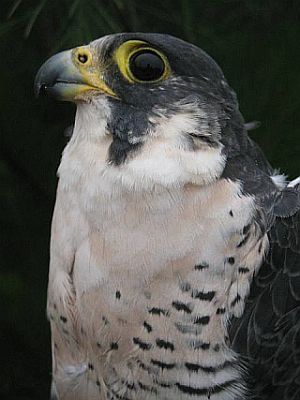NOTE(*) SEPTEMBER 2021: The Southern Cross Peregrine Project and Falcon Research Group websites no longer exist. The links are broken.
24 October 2008
Among peregrines falcons, Dorothy and E2 at University of Pittsburgh are homebodies. They don’t migrate. They don’t wander. They stay home all winter.
Not all adult peregrines behave this way. Those who nest in the arctic are long distance migrants covering 9,000 miles each fall and spring on their way from Canada to South America and back.
Last Friday Peter Robinson posted a message on PABIRDS about an arctic falcon being tracked by the Falcon Research Group (FRG). I was intrigued.
Meet Elizabetha, pictured here by Bud Anderson. She was captured last January near Constitucion, Chile and fitted with a satellite transmitter as part of FRG’s Southern Cross Peregrine Project(*), a study of transcontinental peregrine migration.
In April, three months after she was tagged, Elizabetha left for Baffin Island, Canada where she spent the summer and presumably nested. Baffin Island is a stark place but it has great nesting cliffs and lots of sea birds.
With the nesting season over, Elizabetha headed south. She began her journey on September 23, two days after the equinox. At first she traveled slowly for an arctic peregrine – only about 60 miles per day. When she reached Hudson Strait, the body of water that separates Baffin Island from mainland Canada, she crossed it the long way, flying 156 miles east to west. I was impressed.
And that’s when we then heard about her on PABIRDS because it looked as if she would travel down the Appalachian chain into Pennsylvania. Not Elizabetha. On October 17th she spent the night in northern Maine at Moosehead Lake. The next day she began a two-day power flight that set all records, flying 1,416 miles in the most amazing trip anyone has ever seen.
She left Maine on October 18th and was clocked near Quabbin Reservoir in western Massachusetts at 5:00pm, but she didn’t stop. Eight hours later, at 1:00am October 19th, she was nine miles off the coast of New Jersey flying south at 55mph. She had a good tail wind and – though we didn’t know it – she planned to fly all night. From the coast of New Jersey until she roosted 24 hours later at Ft Pierce, Florida she flew 954 miles over the open Atlantic. Don McCall speculates on the FRG blog that she was helped by the north winds behind Hurricane Omar. Totally awesome!
Elizabetha’s urge to migrate is strong. She knows she has far to go and she’s not wasting any time. Yesterday she was in the Florida Keys. I wonder where she’ll go today.
To follow Elizabetha’s journey, click on her picture.
(photo of Elizabetha by Bud Anderson of the Falcon Research Group)

My gosh! I need a nap just thinking about her journey! Birds really are startling creatues.
ON SATURDAY OCTOBER 25th I SAW A PEREGINE FALCON SITTING ON TOP OF A LIGHT STAND ON THE 62nd STREET BRIDGE AROUND NOONTIME. I AM NOT SURE IF THIS IS A MIGRANT OR IF THIS BIRD HAS BEEN IDENTIFIED?
That’s good news! Perhaps it was one of the resident peregrines who claimed the 62nd Street Bridge before it went under construction last spring. I will let Dan Yagusic know. He’s been monitoring those birds trying to see if they’re still there. They left because the disturbance was so bad.
I wrote about this nest site on my blog at: http://www.birdsoutsidemywindow.org/2008/01/16/bridge-birds-get-a-nest/
though I didn’t mention the 62nd Street Bridge by name.